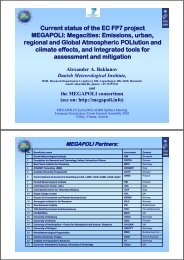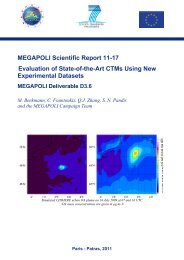D E S C R I P T I O N O F W O R K - MEGAPOLI - Dmi
D E S C R I P T I O N O F W O R K - MEGAPOLI - Dmi
D E S C R I P T I O N O F W O R K - MEGAPOLI - Dmi
Create successful ePaper yourself
Turn your PDF publications into a flip-book with our unique Google optimized e-Paper software.
<strong>MEGAPOLI</strong> 212520<br />
parameterisation for future model development); the UCAM model, with its high resolution capabilities for a global<br />
model, will be particularly useful in providing this information. The sensitivity runs in both T5.4.1 and T5.4.2 will<br />
make use of the two special emissions sensitivity datasets – emissions removal and redistribution – developed in WP1,<br />
Task 7.<br />
Task 5.4.1: Regional scale impacts (lead: FMI). The improved regional CTMs, and selected global models, will be used<br />
to quantify the contribution of the megacity emissions (NOx, ozone, and ultrafine, fine, and coarse PM) in the<br />
surrounding regions of selected megacities. Full-chemistry model computations will be performed in the regions<br />
surrounding Paris for a period of at least a year that contains the campaigns. Longer-term simulations with simplified<br />
chemistry will be conducted for a longer, climatologically representative period. We will also conduct source<br />
apportionment studies using selected models (e.g., PMCAMx), and use reactive tracers (e.g., CHIMERE).<br />
Task 5.4.2: Global impacts (lead: MPIC). Similarly, the global CTMs and CCMs with full chemistry will be used to<br />
assess the impacts of present-day megacity emissions on regional and global ozone and aerosol chemistry, including<br />
deposition fluxes. This will be done for the full set of megacities collectively (level 3 in the pyramid), as well as for<br />
selected megacities or clusters of megacities individually. The redistribution sensitivity runs will provide directly<br />
relevant information to policy makers, and will feed information into WP8 for assessment of mitigation possibilities.<br />
The model output from this task will provide input for WP6.<br />
Task 5.4.3: Megacity pollutant dispersion characteristics (lead: NILU). Calculations will be performed with the global<br />
models to simulate the dispersion of representative artificial tracers released from selected megacities to study their<br />
transport characteristics, including their inter-annual variability, and to discriminate between pollutant build-up in the<br />
surface layer surrounding the cities, long-range export to neighbouring regions, and export to the upper troposphere.<br />
The characteristic time scales will be determined, over which megacity plumes disperse into the hemispheric<br />
background. The results of the regional and global simulations will be inter-compared over common computational<br />
domains. This is useful for the QA/QC of the modelling. These results can also be used for designing similar numerical<br />
experiments within the TF-HTAP (Task Force on Hemispheric Transport of Air Pollutants, http://www.htap.org/).<br />
Task 5.5: The influence of non-urban pollution sources in megacities, and intercontinental transport (lead: DMI, NILU)<br />
Task 5.5.1: The influence of regional-scale pollution on megacities, and inverse modelling of the emissions of<br />
megacities (lead: DMI). In specific episodic conditions, the regional scale emissions (e.g., wild land fires, wood<br />
burning for heating, sea spray, wind-blown dust and various biogenic emissions) can have a substantial, or even a<br />
dominating impact on air quality in megacities. We will analyze their influence on the concentrations in selected<br />
megacities. Inverse model computations will be performed in order to quantify better the contributions of urban<br />
emissions on a regional scale. The inverse computational techniques take advantage of data assimilation methods, such<br />
as 4D-VAR.<br />
T.5.5.2: Intercontinental transport of plumes from megacities or agglomerations of megacities (lead: NILU). Megacity<br />
plumes can have a significant impact on atmospheric composition even after transport across intercontinental distances.<br />
However, this impact is difficult to detect in observational data. Transport of pollution from North American<br />
megacities, in particular the Boston/New York/Washington (Bosnywash) megalopolis, has probably the strongest<br />
impact on Europe of all intercontinental upwind regions. This will be evaluated using existing measurement data from<br />
European background stations (e.g., EMEP) and previous airborne campaigns. The data will be screened for<br />
observations of aged pollution plumes, which will be combined with the FLEXPART simulations to identify periods<br />
influenced by transport from the Bosnywash region. This task will address objectives 5.3 and 5.4.<br />
Task 5.6: Megacity impacts in the future (lead: MetO)<br />
Changes in emissions as well as in climate will affect the impacts of megacities on regional and global atmospheric<br />
composition. These changes will be examined by the global models in this task. The model simulations in Tasks 5.4.1<br />
and 5.4.2 will be used as baseline scenarios. Similar sensitivity runs will then be performed for the future. In one set of<br />
runs, only the emissions (of all types) will be modified to future scenarios (most likely using the IIASA 2030 scenarios<br />
which were employed in the IPCC atmospheric chemistry model intercomparison), and the emissions from megacities<br />
will be removed or redistributed as done in 5.4.2, where the scenarios will be developed in collaboration with WP 8. In<br />
the second set of runs, in addition to the changed emissions, the driving meteorology will also be modified to represent<br />
future climates; the meteorological fields will be obtained through WP6, from the same models as used in this WP. The<br />
analysis will be done in coordination with WP7. By comparing the three types of runs we can determine individually<br />
the role that changes in emissions and changes in climate play in determining how megacities affect atmospheric<br />
composition.<br />
Deliverables<br />
D5.1 Characterization of megacity impact on regional and global scales using satellite data (month 18)<br />
D5.2 Provision of global and regional concentrations fields from initial baseline runs (month 18)<br />
D5.3 Evaluation and improvement of regional model simulations of megacity plumes (month 24)<br />
D5.4 Prediction of megacity impact on regional and global atmospheric composition (month 30)<br />
42




